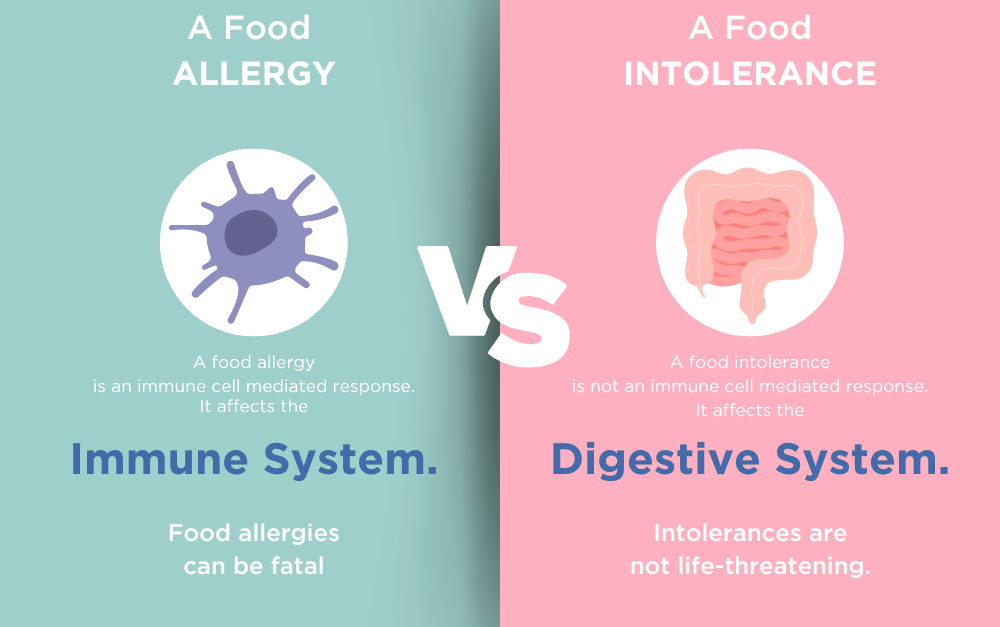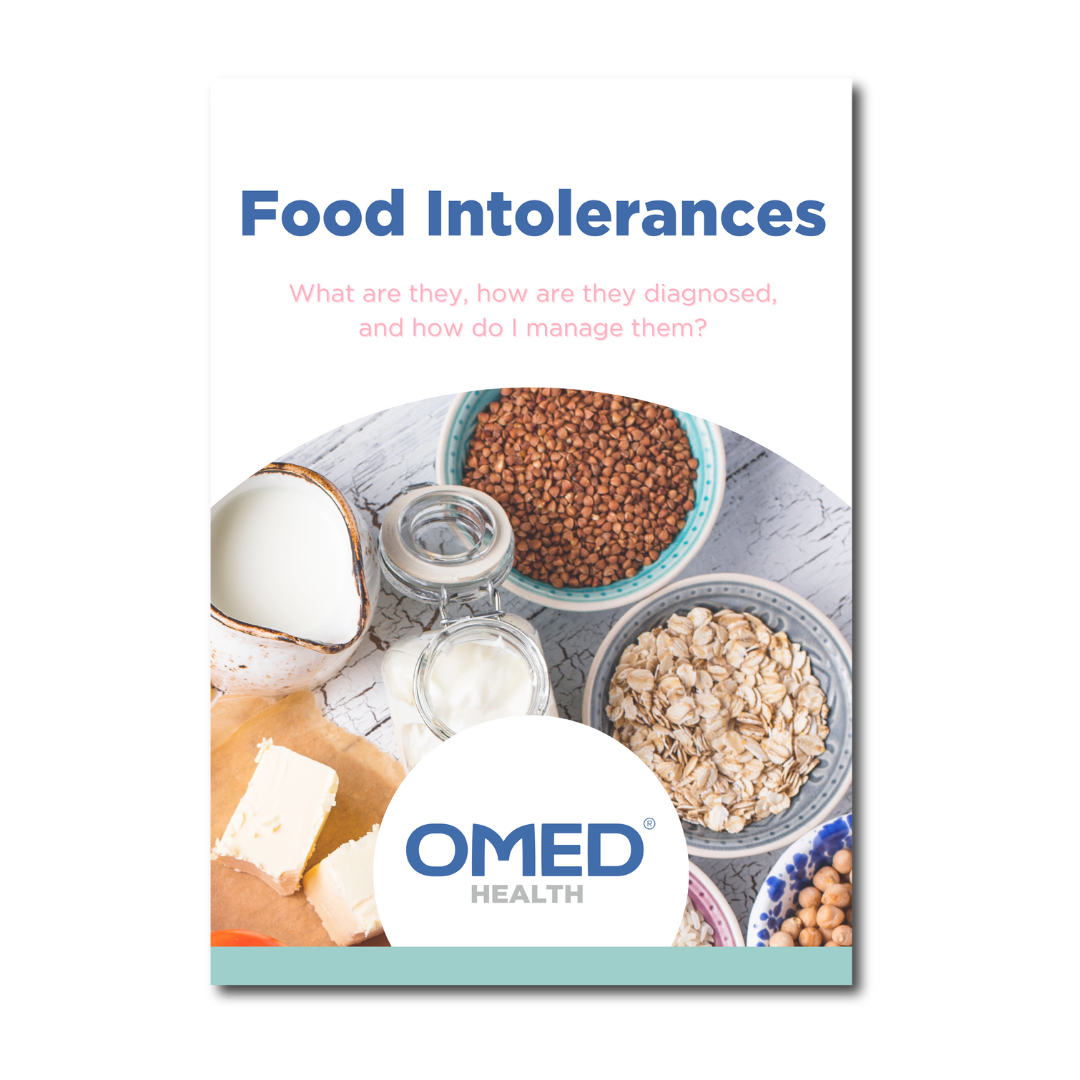Food allergies and intolerances can add an unexpected layer of complexity to our daily eating experiences. Understanding the differences between the two is essential for maintaining a healthy relationship with food. Let’s untangle this confusion surrounding the two, and explore how understanding the difference between the two can go a long way in ensuring our health is looked after when enjoying our food.
What are allergies?
Allergic disorders, such as hay fever, asthma, and eczema affect nearly 25% of people across the globe (1). Food allergies consist of 1-2% of this population. An allergic reaction happens due to the involvement of allergen-specific white blood cells in the immune system, which can specifically recognize allergens such as nuts in certain people (1). This means allergic reactions are our immune system responding to allergens. Allergens are harmless substances found commonly in the environment, but when exposed to people who are sensitive to them, they can cause chronic inflammation – known as an allergic reaction.
Common allergens include grass and tree pollens (hay fever), animal fur, certain foods (such as peanuts, shellfish, milk, and eggs), latex, and some medicines (1). Anaphylaxis is a life-threatening reaction to an allergen and can cause severe respiratory symptoms (2).
What are intolerances?
Food intolerances are abnormal reactions following the ingestion of food. These are non-immunological responses and affect up to 20% of the world’s population (3). Even though they are common, the diagnosis is often not straightforward due to the complicated mechanisms that can cause them to arise – the most common cause of food intolerance is the lack of an enzyme needed to break down and digest the food or ingredient (3).
Most people with this condition report gastrointestinal discomfort symptoms. In patients with gastrointestinal disorders such as irritable bowel syndrome (IBS), up to 84% perceive their symptoms are related to food intolerance (4). However, these patients may not have a food intolerance, it may be a flare-up of their underlying disorder, which is why it is always important to speak with your doctor if you are experiencing symptoms of food intolerance.
What are sensitivities?
Just to make things even more complex, some people can experience symptoms after eating certain foods that are not related to food intolerances or food allergies. These are called food sensitivities and are thought to arise from a mixture of immune response and gut microbiome reactions. The symptoms are not life-threatening, but they can be quite disruptive, such as stomach pain and rashes. These sensitivities can fade with time, as our immune system and gut microbiome are constantly changing, and what may affect us today, may be fine later in life. The best tool to identify food sensitivities is a process of observation, and tracking your symptoms (5).
What is the difference between food allergies and food intolerances?
Understanding the differences between the two is crucial, as these conditions involve many bodily responses that can have significant effects on our health.
Both conditions involve unwanted reactions to food that some people experience, but they are not the same and happen for different reasons:
- When a person has a food allergy, their immune system responds to allergens.
- When a person has a food intolerance, their digestive system cannot break down foods properly (6).

The two conditions also involve different symptoms. An allergic reaction to food can cause:
- Itching.
- Swelling of the face, lips, and tongue.
- Swelling of the throat and airways, causing breathing difficulties.
- Dizziness and fainting.
- Fast irregular pulse (6).
A food intolerance can cause:
- Intestinal gas.
- Stomach pain.
- Diarrhea (6).
As you can see, the main symptoms of food intolerance relate to the gut. The main symptoms of an allergic reaction relate to the immune system. If a person has a known allergy, they must avoid their trigger food as not doing so can be dangerous. They might also need to carry an epi-pen to use in emergencies as the symptoms can be life-threatening. A person with an intolerance can avoid discomfort by avoiding the trigger food, but they will not face a life-threatening situation if they do consume it (6).
Some conditions can present similarly to food allergies and intolerances but are neither. Celiac disease is an autoimmune, chronic digestive condition that is triggered by eating gluten, a protein found mainly in wheat. Celiac disease has some features of a food allergy because it involves an immune response to gluten. The symptoms include gastrointestinal issues, as well as joint pain and headaches, however, people with celiac disease are not at risk of anaphylaxis (7), unlike people with certain food allergies.
Remember that everyone’s response to food is different. You must discuss with your healthcare professional if you are experiencing symptoms of food allergies, intolerance, and sensitivities.
How can OMED Health help?
If you are interested in monitoring your gut health in response to food, our OMED Health Breath Analyzer and App can allow you to track your food intake, symptoms, and the hydrogen and methane levels in your breath. This gives you the ability to monitor your symptoms and reactions to food intake to help identify if you are suffering from any food intolerances or sensitivities.
You can also read our free ebook, ‘Everything you need to know about food intolerances,’ which compiles all of the information you need to understand symptoms, diagnosis and treatments of a food intolerance.
References.
- Galli SJ, Tsai M, Piliponsky AM. The development of allergic inflammation. Nature. 2008 Jul 24;454(7203):445–54. DOI: 10.1038/nature07204
- McLendon K, Sternard BT. Anaphylaxis. In: StatPearls [Internet]. Treasure Island (FL): StatPearls Publishing; 2023 [cited 2023 Dec 14]. Available from: http://www.ncbi.nlm.nih.gov/books/NBK482124/
- Tuck CJ, Biesiekierski JR, Schmid-Grendelmeier P, Pohl D. Food Intolerances. Nutrients. 2019 Jul 22;11(7):1684. DOI: 10.3390/nu11071684
- Lomer MCE. Review article: the aetiology, diagnosis, mechanisms and clinical evidence for food intolerance. Aliment Pharmacol Ther. 2015;41(3):262–75. DOI: 10.1111/apt.13041
- MD MC. Harvard Health. 2020 [cited 2023 Dec 14]. Food allergy, intolerance, or sensitivity: What’s the difference, and why does it matter? Available from: https://www.health.harvard.edu/blog/food-allergy-intolerance-or-sensitivity-whats-the-difference-and-why-does-it-matter-2020013018736
- What’s the difference between food allergy and an intolerance? [Internet]. 2019 [cited 2023 Dec 14]. Available from: https://www.medicalnewstoday.com/articles/263967
- Mayo Clinic [Internet]. [cited 2023 Dec 14]. Food allergy vs. food intolerance: What’s the difference? Available from: https://www.mayoclinic.org/diseases-conditions/food-allergy/expert-answers/food-allergy/faq-20058538




